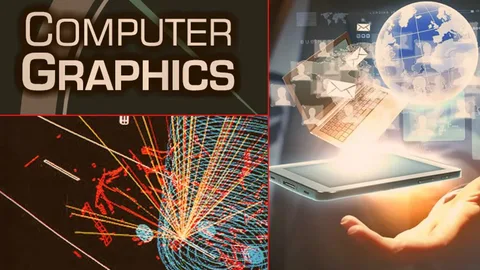The World of Computer Graphics: An Art and Science

Computer graphics is an interdisciplinary field that combines art, technology, and mathematics to create visual content using computers. From stunning visual effects in movies to intricate designs in video games, computer graphics plays a crucial role in various industries, including entertainment, education, and simulation. This article explores the evolution of computer graphics, its key components, applications, and future trends.
The Evolution of Computer Graphics
-
Early Beginnings: The roots of computer graphics can be traced back to the 1960s when pioneers like Ivan Sutherland developed the first computer graphics program, Sketchpad. This innovative software allowed users to draw on a computer screen using a light pen, laying the groundwork for future developments.
-
Advancements in Technology: As technology progressed, so did computer graphics. The 1980s saw the introduction of 2D and 3D rendering techniques, with software like Adobe Illustrator and Autodesk’s AutoCAD becoming popular among designers and architects.
-
The Rise of 3D Graphics: The 1990s marked a significant shift with the advent of 3D graphics. Movies like “Jurassic Park” showcased groundbreaking visual effects, leading to increased demand for 3D modeling and animation skills in the film industry.
-
Real-Time Rendering: The development of graphics processing units (GPUs) in the early 2000s enabled real-time rendering, revolutionizing video gaming and interactive applications. This technology allowed for complex visual effects and detailed environments to be rendered instantly.
Key Components of Computer Graphics
-
Modeling: This involves creating a mathematical representation of a 3D object using geometric shapes. Techniques such as polygonal modeling, NURBS (Non-Uniform Rational B-Splines), and sculpting are commonly used.
-
Rendering: The process of converting a 3D model into a 2D image. Rendering techniques include rasterization, ray tracing, and scanline rendering, each with its strengths and applications.
-
Animation: This aspect involves creating the illusion of movement by displaying a sequence of images. Techniques like keyframing, motion capture, and procedural animation help bring characters and scenes to life.
-
Shading and Texturing: Shading determines how surfaces interact with light, while texturing applies images to 3D models, adding detail and realism. Techniques such as bump mapping and normal mapping enhance surface quality.
-
Post-Processing: This involves applying effects to the final rendered image to enhance visual appeal. Common post-processing techniques include color correction, motion blur, and depth of field.
Applications of Computer Graphics
-
Entertainment: In film and video games, computer graphics create immersive experiences through stunning visuals and lifelike characters. Advances in CGI (computer-generated imagery) have transformed storytelling and audience engagement.
-
Education and Training: Computer graphics are used in educational tools and simulations, providing interactive learning experiences. Virtual reality (VR) and augmented reality (AR) applications help learners visualize complex concepts.
-
Architecture and Design: Architects and designers utilize computer graphics to create realistic visualizations of buildings and interiors. This allows clients to explore designs before construction begins.
-
Medical Imaging: In the medical field, computer graphics are crucial for visualizing complex data from scans and MRIs. 3D models help doctors better understand anatomy and plan surgeries.
-
Scientific Visualization: Researchers use computer graphics to visualize data in fields like climate science, physics, and biology. This aids in understanding complex phenomena and communicating findings.
Future Trends in Computer Graphics
-
Real-Time Ray Tracing: As technology evolves, real-time ray tracing is becoming more feasible, allowing for even more realistic lighting and reflections in graphics.
-
Artificial Intelligence: AI is increasingly being integrated into graphics workflows, enabling automated rendering processes, intelligent upscaling, and enhanced visual effects.
-
Virtual and Augmented Reality: As VR and AR technologies advance, the demand for realistic graphics in immersive environments will grow, creating new opportunities for developers and artists.
-
Procedural Generation: This technique uses algorithms to create complex textures and environments, allowing for vast, detailed worlds in games and simulations without the need for manual modeling.
Conclusion
Computer graphics is a dynamic field that continues to shape how we visualize and interact with the world. From entertainment to education and beyond, its applications are vast and ever-evolving. As technology advances, the potential for innovation in computer graphics remains limitless, promising even more captivating visual experiences in the future. Whether you’re a designer, developer, or simply a fan of stunning visuals, the world of computer graphics offers endless possibilities for creativity and exploration.
- Arts
- Business
- Computers
- Jeux
- Health
- Domicile
- Kids and Teens
- Argent
- News
- Recreation
- Reference
- Regional
- Science
- Shopping
- Society
- Sports
- Бизнес
- Деньги
- Дом
- Досуг
- Здоровье
- Игры
- Искусство
- Источники информации
- Компьютеры
- Наука
- Новости и СМИ
- Общество
- Покупки
- Спорт
- Страны и регионы
- World


